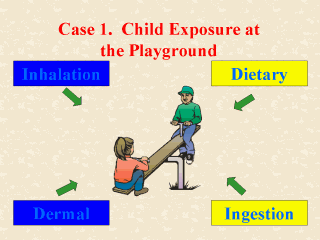| front |1 |2 |3 |4 |5 |6 |7 |8 |9 |10 |11 |12 |13 |14 |15 |16 |17 |18 |19 |20 |21 |22 |23 |24 |review |
 |
In this case
study, the potential sources for oral exposure include: (a) dietary intake; (b) drinking
water; and (c) hand-to-mouth from soil or treated surface. The basic algorithm for
calculating these oral doses is: [oral intake] = [residue level] x [consumption
rate] x [exposure duration]. For dietary intake and ingestion of drinking water, the consumption rate is often measured as amount consumed orally per day. Thus, the last term exposure duration is usually excluded from consideration. The objective of dietary exposure assessment is to quantify the oral consumption or oral intake of the residues in foods that comprise the diets of the population under study, in this case (six-year-old) children living in a specific region. The U.S. Department of Agriculture (e.g., USDA, 1983) has provided dietary consumption estimates based on the results of a series of their Nationwide Food Consumption Survey and the Continuing Survey of Food Intakes by Individuals. Where pesticide is the chemical of concern, the residue levels for the dietary food items can be estimated from field trials, federal monitoring programs, or residue tolerances. A residue tolerance is the maximum residue concentration allowed for a specific pesticide or its metabolites in or on a particular raw agricultural commodity. In some cases, an hourly ingestion rate, rather than a daily rate, is used to estimate hand-to-mouth ingestion of (e.g., soil) residues. For hand-to-mouth ingestion of residues on treated surface, the calculation should start with determining the amount that would be loaded or transferred to the hand(s). |